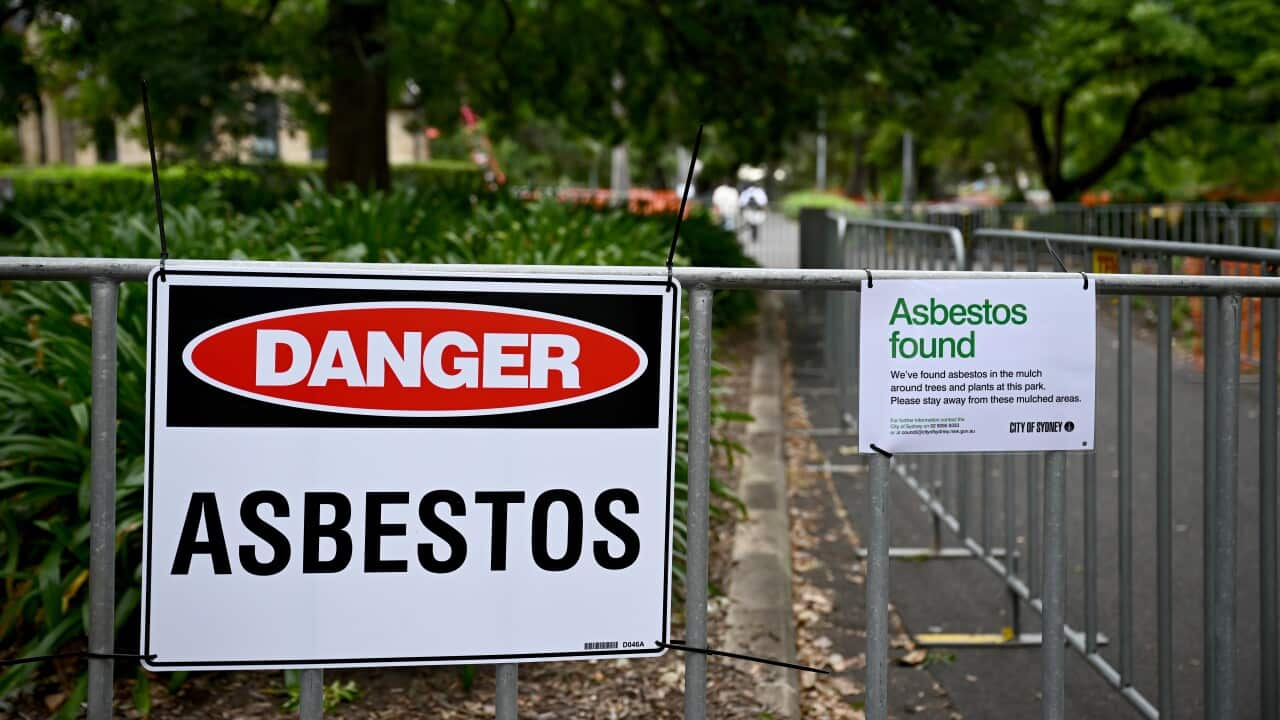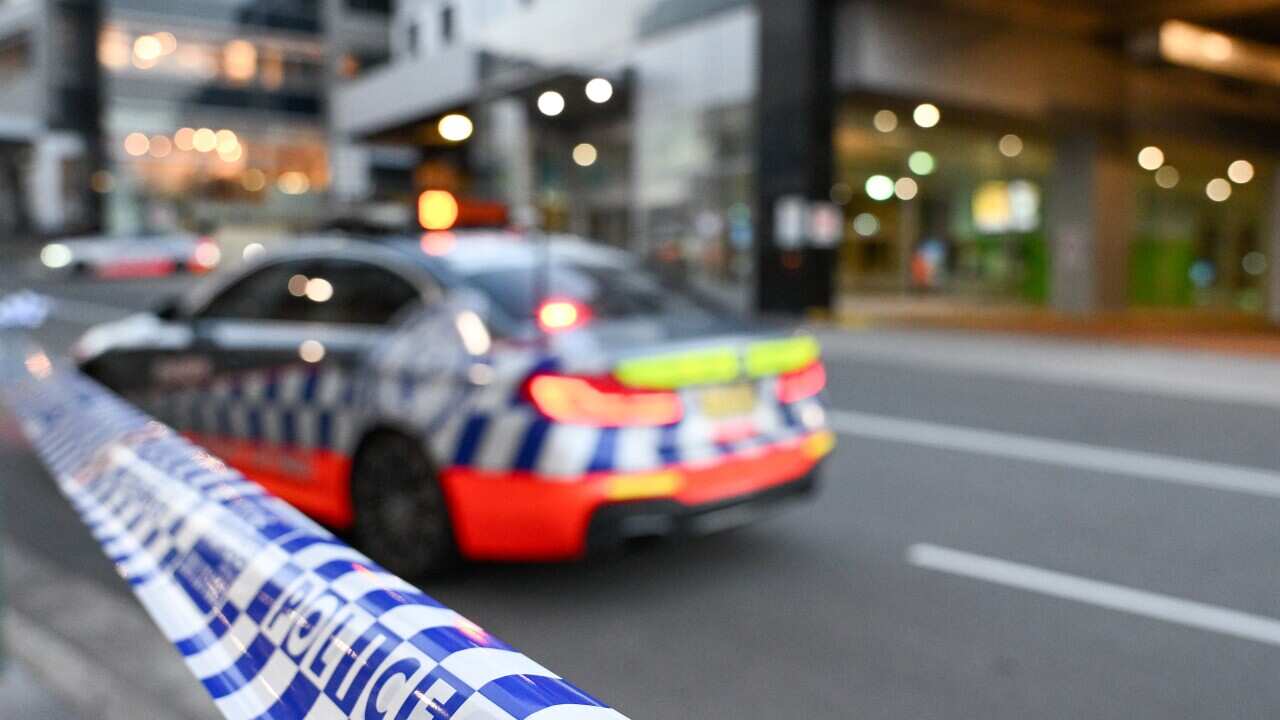Key Points
- Asbestos-contaminated mulch has now been confirmed at more than 40 sites across Sydney.
- The sites include parks, schools, supermarkets, hospitals, private residences and aged care facilities.
- The once-popular building material has been banned in Australia since 2003.
Asbestos has been confirmed at more sites across Sydney as two schools wait on results and hospitals undergo precautionary testing.
One sample confirmed the more dangerous friable asbestos as well as bonded asbestos in mulch at Bicentennial Park on the Glebe foreshore in inner Sydney, after the material was previously found at another park at Surry Hills.
The local council advised the NSW Environmental Protection Authority (EPA) that the area had been fenced off and the agency was awaiting detailed results, the EPA said in a statement on Tuesday.
St Benedict's Catholic College and St Justin's Catholic Parish Primary School at Oran Park in the city's west are undergoing precautionary tests after bonded asbestos was confirmed in mulch at the nearby St Mary Mackillop Catholic Parish.
"Mulch has only been identified on parish property, but precautionary testing will be done at both schools," the EPA said.
Earlier on Monday, Domremy College at Five Dock in Sydney's inner west became another school to confirm asbestos after it was found in mulch at Liverpool West Public School earlier in February.
The college remains open on Monday with the contaminated site isolated and cordoned off.
Education Minister Prue Car said she could not guarantee there would not be more sites affected by contaminated recycled mulch.

Education Minister Prue Car flagged serious penalties for suppliers found to have used recycled mulch in schools, which is not permitted under their contracts. Source: AAP / Bianca De Marchi
"To put this in perspective, we have almost 3000 schools across the state ... and we're talking about 12 (affected) schools that we are managing," she told a budget estimates hearing on Tuesday.
"Something has gone seriously awry here and not just in schools, but across the community."
Precautionary tests are also being conducted at Westmead, Sydney Children's, Hornsby Ku-ring-gai and Nepean Hospitals.
A private aged care facility at St Ives and an industrial area at Rouse Hill were also secured after positive results.
In Sydney's south, a park at Rosebery has been confirmed contaminated.
Another detection was confirmed on a private property, bringing the total to 47 sites since bonded asbestos was detected in mulch at the recently opened Rozelle Parklands in January.
In western Sydney, St Luke's Catholic College at Marsden Park has decided to close this week, while Penrith Christian School at Orchard Hills remains open with the contaminated site fenced off after asbestos discoveries at the two schools were confirmed on Sunday.
An Aldi supermarket at Cobbitty southwest of Sydney will reopen once a contaminated site there has been contained.
A site at Riverstone Sports Centre and an area of a shared path along the Parramatta Light Rail project at Telopea in Sydney's northwest are also set to be contained on Monday.
Asbestos has been confirmed at three other sites which the EPA did not reveal for privacy reasons, saying they are not publicly accessible.
More than 40 sites including schools, hospitals and parks have been contaminated with asbestos contained inside recycled mulch.
The EPA is investigating a complicated supply chain as its probes how the mulch became contaminated.
EPA chief executive Tony Chappel said on Sunday the investigation would conclude with a full report to the public but cautioned against prematurely attributing blame.
What is asbestos?
Asbestos is the name given to six minerals that occur naturally in the environment as bundles of fibres that can be separated into thin, durable threads that are 50-200 times thinner than human hair.
Asbestos is resistant to heat, fire, and chemicals and does not conduct electricity.
For these reasons, it was widely used as a building material in Australia between the 1940s and the 1980s, before the serious health problems it caused came to light and its use was banned in 2003.
There are two kinds of asbestos.
Friable asbestos is more dangerous and can be crumbled or reduced to a powder when it's dry.
Bonded asbestos, also known as non-friable asbestos, is encased in a material and is typically less dangerous — unless it’s broken down into asbestos fibre.
Both friable and bonded asbestos have reportedly been found across Sydney, although it is reportedly mostly the latter
Why is asbestos being found in so many parks?
Asbestos-laden mulch was first found at the Rozelle Parklands in Sydney's inner west in January.
It was subsequently detected at Liverpool West Secondary School in southwest Sydney and Victoria Park in the inner west, which prompted organisers of the .
A major investigation continues into how pieces of bonded asbestos, mostly about the size of a coin, ended up in the commercially sold recycled mulch, which was supplied by Greenlife Resource Recovery.
Last week, the company said its testing showed mulch stockpiled at its facility was free of asbestos contamination and it was confident the material was clean when delivered to contractors for landscaping.
"The company has no visibility of, and does not control, how its mulch is used on a site once delivered … GRRF has no control over whether its products are mixed with other mulches, materials or existing soil that has been disturbed," a statement posted on Greenlife Resource Recovery's website read.
"Further, GRRF understands that many of the government projects and sites on which its mulch has been used and asbestos has been identified were going through or have gone through processes of remediation.
"GRRF understands in many cases this remediation was to address historical contamination with substances likely to be present including asbestos."
How dangerous is asbestos?
Asbestos is extremely fibrous and the tiny fibres are easily breathed in where they can become trapped in the lungs.
Exposure to asbestos increases the risk of developing forms of cancer including lung, ovarian and mesothelioma — the lung lining which is almost exclusively linked to asbestos exposure.
Whilst many who've developed health problems from inhaling asbestos had prolonged exposure, people can develop asbestos-related illnesses after even briefly inhaling asbestos fibres, and even in outdoor settings.
"There’s no minimum exposure," says Dr Tom John, a medical oncologist at the Peter McCallum Cancer Centre in Melbourne. "You can have a minor exposure and still develop cancer."

Asbestos was a popular building material until it was found to cause serious health problems. Source: AAP / Paul Sancya
"It's important to remember that asbestos primarily causes illness when little fibres that are very small, are breathed in," senior health official Jeremy McAnulty said.
"The risk is higher, the more you breathe in over longer periods of time."
How is the NSW government responding?
Contact tracing teams are working to find potential sites containing the contaminated mulch but NSW Premier Chris Minns said last week that resourcing issues prevented the government from closing all parks before they were tested.
"Not every projected park is testing positive to asbestos, but to lock every single park or school or hospital up would be beyond our resources right now," he said.
The state Opposition has called for a searchable central register, similar to a contact tracing database, of all sites under investigation for possible asbestos contamination.
"The public has a right to know if playgrounds and public spaces in their suburbs are under investigation for asbestos contamination," Opposition environment spokeswoman Kellie Sloane said in a statement last week.
A multi-agency task force was set up on 15 February to deal with the unfolding crisis. It includes representatives from the NSW Asbestos Coordination Committee, Safework NSW, Local Government NSW as well as fire, health and education officials.
- Additional reporting by AAP











